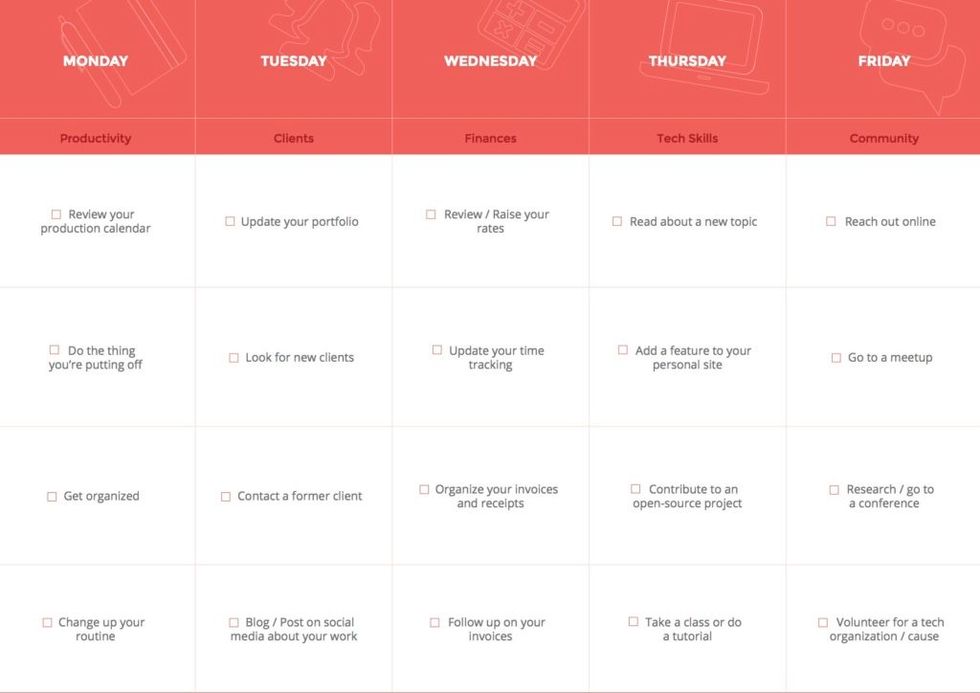A version of this article previously appeared on Skillcrush, an online education program for creatives, thinkers, and makers that gives total tech newbies the tools to make major career changes.
Randle Browning, Skillcrush
This article is a follow-up to The Ultimate Guide to Transitioning Into Freelance, a step-by-step handbook to navigating the 4 phases of leaving your old office job for a flexible freelance lifestyle.
When you launch a new freelance career, there are a million thoughts swimming through your brain:
Can I really do this?
How am I going to finish this project?
What if I don't know enough?
How am I going to talk to clients?
But I'm willing to bet that the most pressing question of all is:
How am I going to make enough money doing this?
Once you've made it through the 4 phases of transitioning into freelance, you're faced with the basic (and yet crucial) issue of making ends meet. But it doesn't have to be rocket science. Whether you've been freelancing for a while, and could use a boost, or you just launched your freelance business, paying attention to these 5 factors can help you raise your rates and make the money you need (without losing your marbles).
But if all of this seems like an insurmountable amount of work, keep in mind that you don't have to do all of these tasks every single day to make sure your business is profitable. In fact, giving due diligence to just ONE of these factors every day can be enough to keep you running to the bank to make deposits. Download the handy 1-Month Calendar to Make Money Freelancing at the bottom of this post and stay on track to do just ONE small task a day. Before you know it, your business will be running like a well-oiled machine.
5 Keys to Making (Lots of) Money Freelancing (even your first year!)
1. Get your finances in order
It makes sense. If you want to figure out how to make more money freelancing, the first thing you should think about…is the money!
FIGURE OUT WHAT YOU NEED
Like I did, most freelancers just starting out spend a lot of energy worrying about how much they can reasonably charge for their web design or development work. They're not always confident asking for substantial amounts of money to work on a project using completely new skills. But in reality, "How much can I charge?" is not the most important question. Instead, you should ask yourself, "What do I need?"
As counterintuitive as it might seem, rather than figuring out how much you want to charge first, you should take a long, hard look at your expenses and figure out how much you NEED to make. Not only will the looking at your expenses all stacked up together make it easier for you to start charging (you NEED the cash!), it also means you're more in control of your freelance work. For example, if you know you need to make $5,000 this month, are you likely to accept a 2-week project that pays $100? Check out this guide to calculating your rate to see how much you truly need to bring in.
And don't forget to think about the perks you might have been used to at your former desk job. Being a freelancer means lots of freedom, but you also need to set up your OWN benefits package to find out exactly how much money you need to make to cover your freelance business expenses.
KEEP TRACK OF EVERYTHING
And don't stop there. Make sure you keep track of your expenses as you go, from tracking your hours, to keeping a folder full of business-related expenses, client coffee dates included. One of the most common mistakes new freelancers make is the tendency to lose track of important documents, like invoices and receipts. You can't get paid if you don't keep a record of your work!
RAISE YOUR RATES ON THE REGULAR
As you start freelancing, you'll probably notice a trend. If you charged $150 for your very first project, you'll probably charge double that for the next one. And once you realize how many hours these projects really take, before you know it, you'll be charging exponentially more than you did at first. I know I did. In a few months I went from charging a few hundred dollars per project to a few thousand.
And that's good. As your skills and experience improve, your rates should go up accordingly. For a guide on what to factor in when setting your rates, check out this Ultimate Guide to Charging for Freelance Work.
And once if you want to show clients exactly what they're paying for, use this Foolproof Formula for Calculating Your Price to help them make sense of your new rates. You'd be surprised what a few simple tweaks to the way you present your prices can do. One tiny trick that actually involves taking awayzeroes can make you richer.
And if you can't convince your clients to pay for your new rates, you might need to think about what YOU can do to make your work seem (and be!) more valuable.
KEEP THE TAX MAN HAPPY
And of course, you can't forget about good old-fashioned responsibility while you're counting your cash on Cloud 9. To make sure you get to KEEP that hard-earned money, find out everything you need to know about freelance taxes before April rolls around.
PROTECT YOURSELF FROM CALAMITY
That might sound dramatic, but you wouldn't leave your wallet on your front porch, I'm guessing. Keep your earnings (and your business) safe. To protect yourself from liability (and hefty legal costs) by always using a custom contract. This isn't a time for the DIY mentality—in fact, "do it yourself" contracts can be one of the biggest pitfalls freelancers find themselves in!
2. Stay productive
Your first year of freelancing is sure to keep you busy either working with all your new clients or working hard to get new ones. You'll need to stay productive to be able to do it all – and still have a life!
USE THE TOOLS
Two essentials you should make sure you have in your freelancing toolkit are a production calendar and a to-do list. The calendar is where you'll plan out the steps for each projects to make sure you have a realistic schedule that also meets your client's deadlines. And the to-do list is where you'll keep track of the work for each phase of the project as well as the tasks needed to keep your freelance business running.
JUST DO IT!
Speaking of those tasks… There are bound to be a few parts of running your own business that you're not so excited about. Now that you're on your own you won't be able to pawn these off on anyone else. To get the tasks off your to-do list and off your mind is to do them as soon as you can. That way, you'll stay on top of your business and your client work – a sure way to be productive in your first year!
KEEP IT TOGETHER
When you get busy, it can be tempting to let your freelancing "housekeeping" fall by the wayside. (Not to mention actual housekeeping. Laundry – Ugh!) But you'll be much more effective if you make a regular habit of organizing your files – both paper and digital, going through your snail mail and email, and tidying up your workspace. When you know what you have and where you can spend your time and energy focusing on your freelancing.
REFRESH AND RECHARGE
No matter how much you enjoy your work, sometimes the best way to stay effective is to STOP working! Just because you aren't doing the 9-to-5 with a boss watching over you, you still need to draw a line between work and play. So, get the most out of your weekends and free time, and don't forget vacations now and then. You'll come back full of energy, ideas, and excitement – aka some serious productivity mojo!
3. Get clients and keep them happy
If you spend most of your days alone with your code editor, talking to clients can feel like a major shift. And many freelancers struggle more with client relationships than with code. But just like coding, you can master the art of keeping your clients (and you!) happy by taking it one bit at a time. And remember, without happy clients, there's no money, honey.
SET THE "BAIT"
Okay, clients aren't fish, but you do have to do some work to hook them in. Start by making sure your new tech portfolio is killing it. You don't have to be an expert to have a well-stocked portfolio. You just need to figure out How to Build an Impressive Portfolio When You're New to Tech.
Start by doing unpaid projects (that pay off in other ways, like experience and publicity), and move on to smaller projects that can earn you $500 or so. And as you're gaining experience and a track record for excellent work, take some time to build your personal brand. A personal brand ensures that your potential clients "know you for" something, and it build your credibility (and clients' trust in you). Win, win!
GET IN TOUCH
But don't expect your portfolio to do all the work. Make sure clients know about you by sending out emails looking for work—these 5 email templates are a great place to start—and make the most of social media by perfecting your Twitter bio and updating your LinkedIn. Starting a blog is a great way to get noticed too.
MAKE THEM HAPPY
And once you have your clients, if you want them to be paying customers, do everything it takes to earn their trust. That means saying and doing all the right things the very first time you meet them, and keeping them satisfied throughout the process by doing everything from asking them zillions of questions to meeting deadlines.
DEAL WITH STICKY SITUATIONS
Of course, there's no way to keep clients happy 24/7, so when something DOES go wrong, make sure you're ready to handle it in the most diplomatic way. These email templates cover everything from what to say if you're not going to meet a deadline to how to mend a miscommunication. They should keep you from making any serious faux-pas or irreparably damaging your client relationship.
REMEMBER THE LITTLE THINGS
Clients are people too. A sure way to turn a client into a repeat customer is to show your appreciation through little things like occasional personal emails (just to check in), and sending customized holiday cards.
4. Make sure you still have in-demand skills.
Part of what makes tech such an exciting industry is the fact that it's always changing. This means new software, hardware, technologies, and trends you can offer your clients. But first you have to know how to use them! You can think of it as "learning for earning".
CATCH UP ON YOUR READING
Thanks to the Internet, you have a world of information just a mouse-click away. You can keep up on freelancing and tech on blogs, forums, and even Twitter. Make it a regular habit, and you'll always know what's up and coming so you can keep your clients informed and impressed.
PRACTICE MAKES PERFECT
If you want to keep practicing your craft without having to worry about your client's reaction to your experimentation, try things out on your own personal site. Try out that new jQuery effect or revamp your color palette. It'll let you put your skills to the test and will keep your portfolio looking fresh too.
STAY OPEN
Or you can do some "real life" work on an open-source project to keep yourself sharp. Open source is an amazing opportunity to build up your tech karma while also getting experience and exposure for your talents. And, like tweaking your own site, you'll be able to do it without the pressure of a paying client.
GET SOME CLASS
To really move ahead with your freelancing, invest in a course or tutorial to learn a new skill or improve your current knowledge. For example, if you're a web designer, find out about web development. Or, if you're a web developer, learn about WordPress. Not sure where to start? Check out all our Skillcrush Blueprints to take your skills to the next level!
5. Become part of the tech community
Just because you're going it alone doesn't mean you have to be lonely. By getting involved in the tech community, you'll find people with the same interests who you can learn from, have fun with, and maybe even work with.
GO VIRTUAL
Wherever you live in the world, you can take part in online forms, follow industry leaders and innovators on Twitter, or take part in workshops and conferences virtually. So don't let location or your lifestyle hold you back from finding a community.
MEET AT A MEET-UP
The meet-up is a phenomena that tech has especially embraced. These groups, that get together regularly, are nearly always very welcoming to people of all skills levels and backgrounds so don't be shy. If you just show up and introduce yourself, you'll soon have a whole clan of people who share your same passions and can give you plenty of tips and support.
COMMIT TO A CONFERENCE
Conferences are also huge in tech, and there are plenty of huge ones – and not so huge ones – all around the world. Just do some Googling to find ones in places you'd like to visit and then start making travel plans. Even though the trip will be an investment, it'll pay off when you meet tons of new people, make in-person connections, and hear about the hottest topics in tech.
GIVE AS GOOD AS YOU GET
Once you've found the communities you love, you can "pay it forward" by volunteering with the group. It's what keeps most of these groups going so that more newcomers like you can benefit from them. And it's also a chance to work with more people in the industry and even gain some skills and experience that could help you out with your freelancing. Not bad for a little unpaid side project!
And if all of these categories feel like too much to keep track of, do NOT worry! Paying attention to each of these areas just once a month is enough to maximize your earning. Just follow this simple 1-Month Calendar to Making Money Your Freelancing. Have you ever seen one of those chores calendars? This is like that, except all of the tasks are challenging and fun, and sure to yield results in your bank account. Download it right this minute, and get ready to watch your bank account grow.






